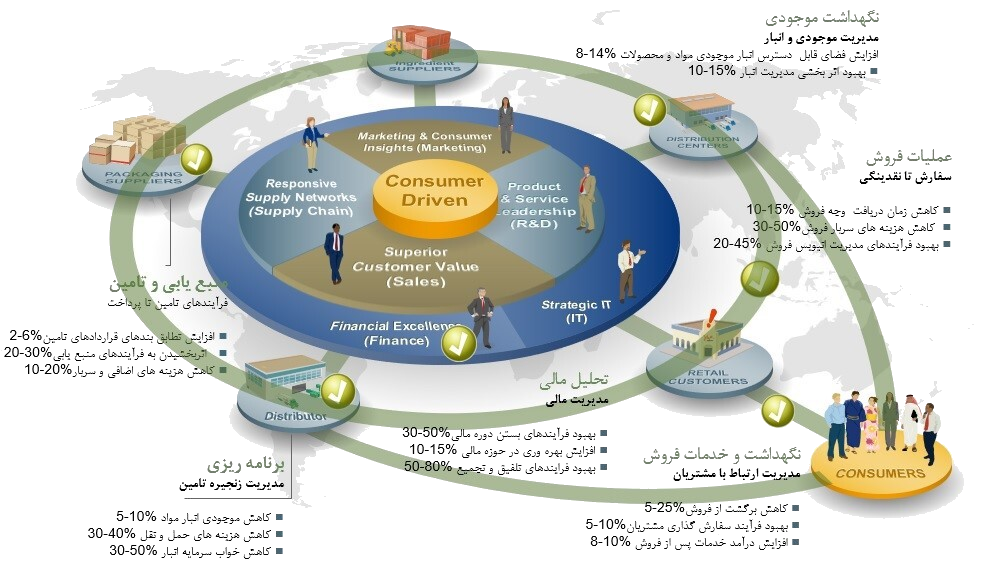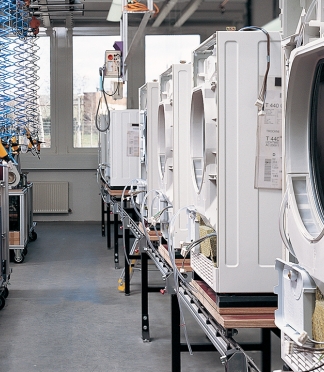صنایع غذایی
صنایع تولید و بسته بندی محصولات غذایی و نوشیدنی

چالش های مشترک پیش روی صنایغ غذایی :

با استقرار SAP-ERP در سازمان ، امکان تمرکز بر نیازمندی های مشتری و بازار فراهم می شود و با این رویکرد عمده شاخص های کلیدی عملکرد سازمان KPI های به میزان قابل توجهی بهبود خواهد یافت.
SAP Direct Distribution
در این ویدئو دمویی از سیستم پخش SAP روی موبایل نشان داده میشود که شامل چک کردن مسیر روزانه و برنامه ویزیت مشتریان ؛ بارگیری ، یافتن بهترین مسیر ، تحویل به مشتری پرداخت و امضا الکترونیکی میباشد.

-
برنامه ریزی استراتژیک
Building on market development and consumer trends companies define their strategies and drivers for growth based on their Vision, Mission and Values to maximize return across the value chain. In the planning phase individual business units plan how to support the overall company objectives based on the overall strategic goals
-
توسعه محصول (معرفی و توسعه محصولات جدید)
To develop innovative products is probably the most important process for the CP industry, but also one of the least well understood. Important because, innovative products are responsible for the revenues and margins that a food company can achieve and its ultimate value. Least well understood because few companies assign a single individual to be responsible for the whole process. Instead, it is usually driven through a series of functional “silos” causing delays to build up and, often, the original market requirements to get lost. The time to transform an idea into a new product and launch it is too long and filled with costly delays. The average time-to-market in the CP industry is about 28 months, the best in peer needs 17 months (AMR Benchmark Analytics 2003). But, driven by consumer demand and fuelled by advances in technology, CP companies have to bring more and more products to market in order to remain competitive. The companies best able to develop and launch innovative products will clearly have an advantage. This is mostly reducing time to market. Under these circumstances, CP companies are eager to streamline their development processes.
SAP can provide all of the critical elements required to support shortened time-to-market processes.
-
برنامه ریزی یکپارچه زنجیره تأمین
Along with the product goes the planning of required resources in production, distribution and transportation (shipping & handling) of the products via different channels to the end consumer. The other dimension includes the forecasting and planning of all necessary material to satisfy the requirements from sales and marketing
-
منبع یابی و تأمین
In the Consumer Goods Industry the purchase volume is about 40-70% of net sales. This means a reduction of the total cost of procurement significantly influences profit. That’s why Sourcing and Procurement gets more and more on the radar screen of those companies. Gaining effectivity in purchasing and transforming their businesses accordingly is on the top task list of CPO’s today.
While automatisation of processes and greater spend visibility in procurement of indirect goods is still a key objective, integration with planning systems to streamline plan-driven procurement and speed up production cycle times is the other focus point in the area of operational procurement.
On the sourcing side there is a trend for professional purchasers to work more strategically and automate operational tasks or outsource them internally or externally. They need highly sophisticated analytical tools for e.g. spend analysis, supplier performance measurement, procurement controlling etc. Supplier selection, supplier evaluation and contract management are more the tactical tools they are using in the strategic purchasing process. -
ورود به بازار (بازاریابی)
As CP companies are becoming more and more Consumer centric the understanding and anticipating of consumer needs and market trends drive the overall activities in CPG companies to finally increase consumer satisfaction and support the corporate strategy. Marketing generates demand by attracting attention of the consumer towards a certain brand by using innovations and different activities directly towards the consumer as well as the Retailer. Effective set-up and control of all marketing support is necessary for being present on retailers’ shelves and in consumers’ minds.
-
مدیریت فروش (مدیریت عوامل فروش، عملیات فروش و فروش مستقیم)
As Food companies are becoming more and more consumer centric, the understanding and anticipating of consumer needs and market trends drive the overall activities to increase consumer satisfaction and support corporate strategy.
Sales Execution includes all business processes for the sale of goods and for the distribution to the customers.
-
تحقق تقاضا (تولید، بسته بندی، لجستیک)
Along with the finished product goes the fulfillment and execution to ensure the availability of the brands and products at the Retailer's shelf at the right place and time through this part of the value chain including the production, distribution and transportation. It includes the physical shipping and handling of the products via different channels to the retailer and end consumer to avoid out of stocks and to ensure customer satisfaction. Out-of-stocks on Retailers’ shelves and displays means lost revenue and damaged consumer loyalty. Maintaining high inventory levels to avoid out-of-stocks is expensive. To find the optimal balance, all steps of the distribution process need to be optimized and transparent.









